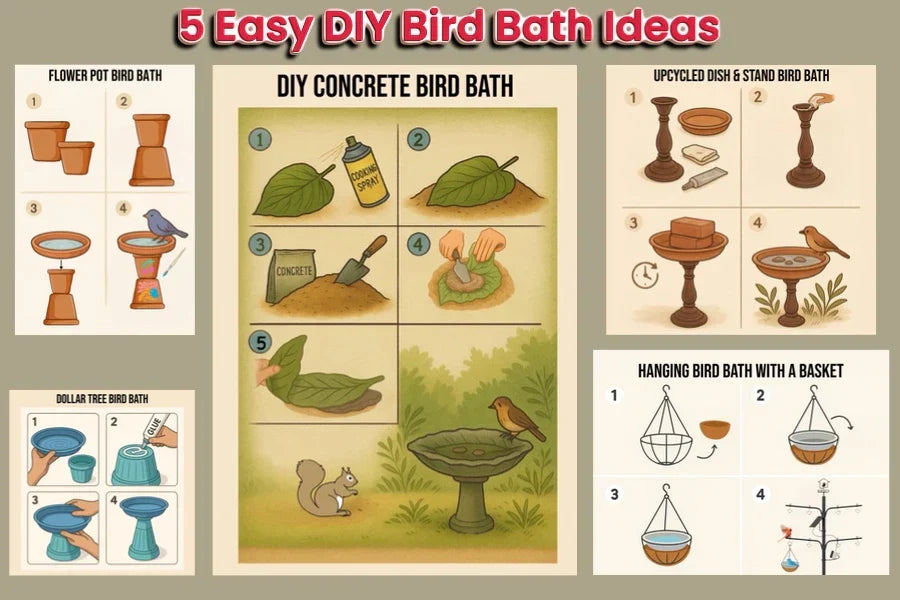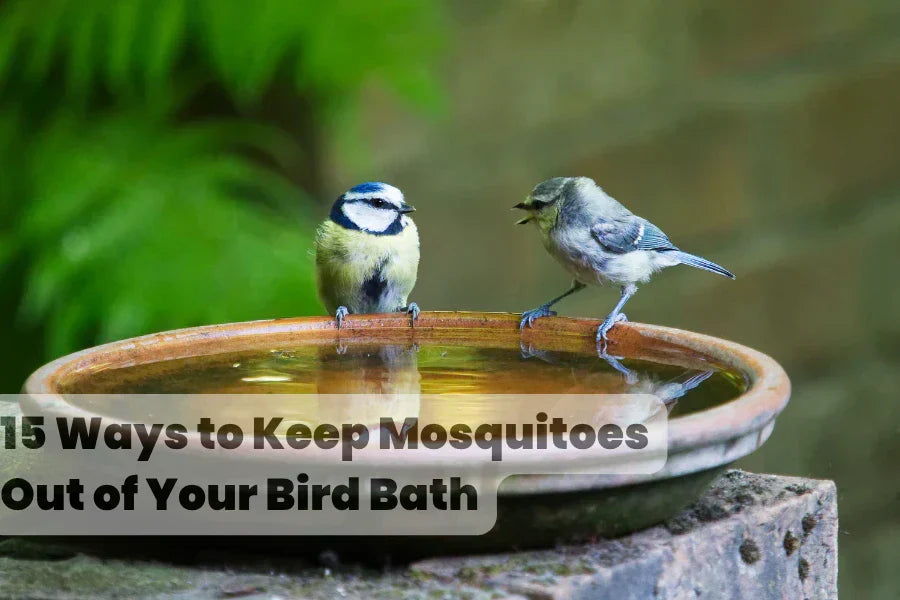Bird baths make a wonderful addition to any garden, offering birds a refreshing place to drink and bathe while bringing nature closer to home. However, without proper care, the still water in bird baths can quickly turn into a breeding ground for mosquitoes, which can be annoying and pose health risks. The good news is that with the right strategies, you can keep mosquitoes out of bird bath. In this guide, we’ll explore 15 effective ways to do just that.
Strategies to Keep Mosquitoes Out of Bird Baths
In this section, we’ll walk you through 15 practical tips to keep mosquitoes out of your bird bath. Feel free to choose the methods that best suit your setup and routine.
Method 1. Regular Cleaning
Clean your bird bath at least once a week, or more often if you notice debris or algae accumulating. Use a brush and a mild soap solution to scrub the basin. Rinse thoroughly to ensure no soap residue remains, as this can be harmful to birds.
Method 2. Change Water Frequently
Fresh water discourages mosquitoes from laying eggs since they prefer stagnant water for breeding. Regularly replacing the water breaks the mosquito life cycle.
Change the water in your bird bath every three to four days.
Method 3. Add Mosquito Dunks
What Are Mosquito Dunks?
Mosquito dunks are small, donut-shaped tablets containing a natural bacterium called Bacillus thuringiensis israelensis (Bti), which is toxic to mosquito larvae.
Are mosquito dunks safe for birds?
Yes, mosquito dunks are considered safe for birds, pets, and other wildlife. Find those brands on Amazon that specifically target mosquito larvae and do not harm birds when used as directed. It's an effective, non-toxic solution for keeping your bird bath mosquito-free.
How to use Mosquito Dunks in the bird bath?
Follow the manufacturer’s instructions to determine how many dunks to use based on the size of your bird bath. Typically, one dunk is sufficient for smaller baths.
Method 4. Use a Solar Fountain
Installing a solar-powered fountain creates movement in the water, making it less attractive for mosquitoes to breed. The constant movement of water not only prevents stagnation but also attracts birds, who enjoy bathing and drinking from flowing water.
Depending on the setup of your bird bath, here are a few things to consider when choosing a solar fountain:
Pump strength: Look for a flow rate between 150–250 L/h (liters per hour). This is enough to keep the water moving—deterring mosquitoes—without creating a stream that scares away smaller birds.
Solar panel power: Aim for 1.5–2.5 watts. If your bird bath gets a lot of sun, 1.5W is usually plenty to keep things running smoothly.
Ease of cleaning: Choose a fountain that’s easy to take apart and clean regularly to prevent algae buildup or clogs from debris.
And most importantly, stay in touch with the seller when shopping. With the right questions, you’re likely to find a fountain that works perfectly for your needs!
Method 5. Try Birdfy Bird Bath – Built-in Solar Fountain
Did you know there are bird baths that come with a built-in solar fountain? Take the Birdfy Bird Bath, for example. This smart bird bath features a 1.9W solar panel, a 9000mAh battery, and dual HD smart cameras—delivering reliable power for both water flow and video recording, day and night.
The Birdfy team has thoroughly tested this product to ensure bird safety. The water basin is 4.2 cm deep, just the right depth for birds to splash, drink, and bathe without risk.
Why choose the Birdfy Bird Bath?
Flowing Water: The sound of moving water attracts birds and helps prevent mosquitoes from laying eggs.
5 interchangeable nozzles: change up the water spray style anytime
Dual power: solar + battery, reliable performance, even on cloudy days
Dual HD cameras: enjoy stunning footage of your backyard visitors
AI recognition of 6,000+ bird species: learn more about every feathered friend that visits
Shop Now
The installation is super easy, letting you start birdwatching in no time!
Method 6. Buy Bird Bath Water Agitator
Water agitators are devices that create gentle ripples on the water’s surface without the need for a fountain. They typically use small motors to prevent water stagnation. These devices help keep the water fresh and reduce mosquito activity. To use a water agitator in your birdbath, simply power it with a battery and place the agitator in the center of the basin.
Method 7. Incorporate Natural Mosquito Repellents
Surround your bird bath with mosquito-repelling plants such as citronella, lavender, or marigolds. Their scents can help deter mosquitoes.
Method 8. Add Fish to Larger Water Features
If your bird bath is large enough, adding small fish like guppies can help control mosquito larvae, as they will eat the larvae.
👋 Ensure that the fish species you choose are compatible with the local ecosystem and are not invasive.
Method 9. Keep Surrounding Areas Dry
Check your yard for areas that may collect water, such as clogged gutters, overwatered plants, or low-lying areas. Ensure that these areas are drained or filled to minimize potential breeding sites close to your bird bath.
Method 10. Monitor for Debris
Keep an eye on the bird bath for fallen leaves, twigs, or other debris that can hold water. Remove debris promptly to ensure the water remains clean and less inviting for mosquitoes.
Method 11. Consider the Location of the Bird Bath
Position your bird bath in a sunny spot (not direct sun exposure), as mosquitoes prefer shaded areas for breeding. Ensure the bath is not too close to dense foliage or standing water. A well-lit, open area will deter mosquitoes. For more details, check out our complete guide on how to place a bird bath in the best location.
Method 12. Implement a Seasonal Strategy
Adjustments by Season: In warmer months, when mosquitoes are most active, you may need to increase your cleaning frequency and change the water more often.
Winter Prep: During the colder months, consider using a heated bird bath to keep the water from freezing. Even in mild winter weather, stagnant water can still become a breeding ground for mosquitoes.
👋 The Birdfy Bird Bath is compatible with an optional heated solar fountain.
Method 13. Monitor Weather Conditions
After heavy rain, check your bird bath to make sure the water hasn’t gotten dirty or stagnant. If more rain is expected, it’s a good idea to drain any standing water ahead of time to help prevent mosquitoes from moving in.
Method 14. Create a Diverse Habitat
Biodiversity: Encourage other wildlife in your garden, such as dragonflies and frogs, which are natural predators of mosquitoes.
Plant Variety: A diverse plant landscape can help attract these beneficial creatures, creating a balanced ecosystem that controls mosquito populations naturally. Consider adding native plants like bee balm, milkweed, coneflowers, marigolds, or lavender, which can draw in birds, butterflies, and other mosquito-eating insects like dragonflies.
Method 15. Team Up with Your Neighbors
If your neighborhood has several bird baths, ponds, or other water features, consider chatting with your neighbors about simple mosquito prevention tips. Working together not only helps keep everyone’s yards more enjoyable, but also shows shared responsibility for your local environment. A little teamwork can go a long way in cutting down the mosquito population in your area.
FAQ About Bird Bath Mosquito Prevention
❓How to Prevent Mosquitoes Breeding in Water Fountain
To prevent mosquitoes from breeding in a water fountain, ensure that the water is continuously flowing. Use a fountain pump to create movement, as stagnant water is ideal for mosquito reproduction. Regularly clean the fountain and change the water to keep it fresh. Adding mosquito dunks or natural larvicides can also help control any potential larvae.
❓Can You Use Mosquito Dunks in a Pond?
Yes, mosquito dunks can be safely used in ponds. They are designed to target mosquito larvae without harming fish, birds, or other wildlife. Follow the instructions on the packaging for the appropriate dosage based on the size of your pond. Regular monitoring of the pond will ensure that the mosquito population is kept in check.
❓Are Mosquito Dunks Safe for Dogs or Cats?
Mosquito dunks are generally considered safe for pets, including dogs and cats, when used as directed. The active ingredient, Bacillus thuringiensis israelensis (Bti), is a naturally occurring bacterium that is harmless to animals. However, it’s always best to supervise pets around treated areas to ensure they don’t ingest the dunks directly.
❓Are Mosquito Dunks Safe for Squirrels?
Yes, mosquito dunks are safe for squirrels and other wildlife. The Bti in the dunks targets only mosquito larvae and does not pose a threat to other animals, including squirrels. This makes them an environmentally friendly option for controlling mosquito populations without harming beneficial wildlife.
Conclusion
Keeping mosquitoes out of your bird bath is essential for creating a safe and comfortable environment for birds while minimizing the presence of pesky insects. By following the 15 tips outlined in this article, you can significantly reduce the chances of mosquitoes breeding in your bird bath. Whether you choose to incorporate Birdfy Bird Bath’s solar-powered fountain technology or prefer more natural solutions, you’ll be able to strike the perfect balance between attracting birds and repelling mosquitoes.






